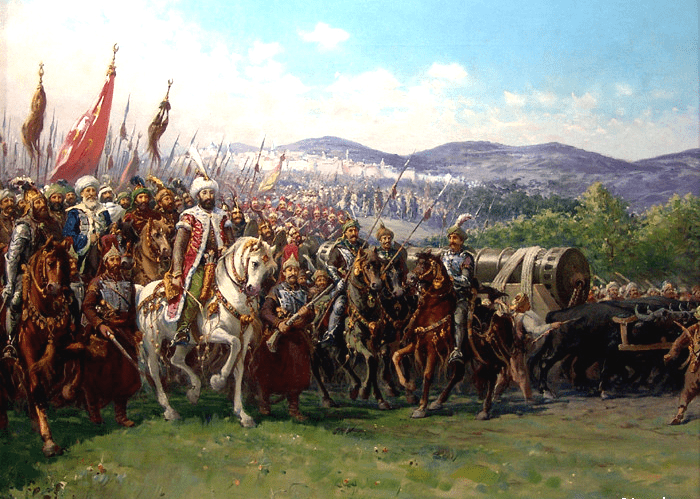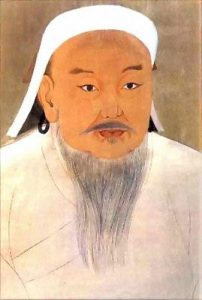How do you beat a good defense? By having a better offense. In the year 1453, one of the greatest showcases of artillery advancement in history took place. There were two groups in conflict, each known for a strength opposite the other: one was known for its indestructible defensive walls, and the other known for its weapons of assault. These two sides were the Byzantines and the Ottomans. The event bringing them together was siege of the Byzantine capital Constantinople. The aftermath of this siege was the recognition of the Ottomans as a new major power in the world. Their victory over the Byzantine Empire, heir to the ancient Roman Empire, marked the waning of the Middle Ages and the early dawning of a new age to come, the Early Modern era.

Mehmed II was the ruler of the Ottoman people when he seized control of the Byzantine Empire. At age eighteen, when he first got power, there was a backlash within the ranks of his commanders. Mehmed II was forced out of power. His father, Mehmed I, had to help his son regain his power. This event fueled Mehmed II’s sense of conquering, having been betrayed by his own people for power.1 The Ottoman army was known as one of the first groups to use gunpowder. In their military attacks, it was a clash of great defense versus a great offense. At the age of twenty-one, Mehmed II lead a military attack against the Byzantine Empire with a weapon known as the Orban cannon, the biggest cannon ever seen in the medieval world. The measurements of this unique cannon were about 27 feet long. It was walled with 8 inches of solid bronze and had a diameter of 30 inches. The target was the unbreakable walls of Constantinople, which the maker of the cannon had had a great deal of time studying. Constantinople was the yet-unconquered capital, and for over a thousand years it had only been captured once, in 1204. The Ottomans saw it as a perfect capital for the empire they hoped to rule. The walls, however, posed a great problem for any foreign invader, because of their height and depth. Therefore, Mehmed II had this special cannon built. The rest of the Byzantine Empire had already been conquered by the Ottomans, and Constantinople was the last remaining piece to be taken.2
The architect behind the destructive cannon was a man named Orban. There is not much information on his earlier life. We have very little information about him regarding the creation of his cannons. Orban was a Hungarian cannon maker. He was opportunistic. No matter who employed him, he just wanted to create the next big cannon. He first began his campaign at the unconquered city of Constantinople, stopping there to sell his services and ideas to Emperor Constantine XI. He liked Orban’s idea for a super-weapon cannon, but he was not willing to offer him much funding for the project. Growing frustrated with Constantine’s financial support, Orban decided to go to the opposing force in the war. He went to see Mehmed II and offer him his services. When the two met, “Mehmed asked Orban if he could cast a cannon large enough to smash the walls of Constantinople.” Orban replied with “I can cast a cannon of bronze with the capacity of the stone you want. I have examined the walls of the city in great detail. I can shatter to dust not only these walls with the stones from my gun, but the very walls of Babylon.”3 Orban proceeded to work on the cannons, and once he was finished, Mehmed ordered a test shot in front of his palace. The test was amazing. The cannon shot its projectile over a mile. The fear it then would strike into the opponent’s hearts was incomparable to anything known. The sheer power of the weapon was terrifying.

With the final product finished, the hard part began: the transportation of the cannon for a trip of 140 miles to the destination. The moving team was quite impressive. With 200 men and 60 oxen, it took six weeks for the guns to arrive, along with 80,000 soldiers all under the command of Mehmed II.4 His men cleared the tree lines and anything else in its path for a clear shot at the wall. An eyewitness of the battle described the destruction of the cannon: “sometimes it would destroy a complete portion of the wall.”3 This was the beginning of the end for the most indestructible object in the world. Mehmed II was ruthless in his tactics, cutting off all escape routes and all incoming supplies. The result was a 53-day siege, leaving the walls in ruins.

This, the dawn of the gunpowder era, spelled the end of the Middle Ages and the beginning of a new age of warfare. The effects of this battle saw a major change in the modern army’s artillery and the use of gunpowder for armys around the world. The recognition of the Ottoman Empire as a world power increased after this war, along with Mehmed II’s reputation in the empire.
- Charles Foster, “The fall of Constantinople and the end of an empire,” Contemporary Review Vol. 288 Issue 1682 (Autumn 2006): 379. ↵
- Franz Babinger, Mehmed the Conqueror and His Time (New Jersey: Princeton University Press, 1978), 85. ↵
- Roger Crowley, “The guns of Constantinople: history’s first great artillery barrage, in 1453, shattered the Byzantine capital and changed warfare forever,” Military History Vol. 24 Issue 6 (Sept 2007): 44. ↵
- World History Encyclopedia, 2011, s.v. “The Ottomans as a Gunpowder Empire,” by Alfred J. Andrea and Carolyn Neel. ↵
- Roger Crowley, “The guns of Constantinople: history’s first great artillery barrage, in 1453, shattered the Byzantine capital and changed warfare forever,” Military History Vol. 24 Issue 6 (Sept 2007): 44. ↵



43 comments
Kenneth Gilley
I had not heard of the Orban cannon until I read this article. I cannot imagine the terror and despair of the Byzantines when they saw their precious and famous walls being blasted into pieces by an enemy too far away for them to even think of attacking. I wonder how it would have altered history if Constantine XI had provided more funding for Orban’s plans. This was a great article!
Michael Leary
Very interesting article, it was very interesting to learn about the gun that destroyed the city walls of Constantinople. This was a very interesting story because I had not heard about the story about how a weapon smith was looking to make a weapon of mass destruction, not caring who it was for. The Siege of Constantinople proved to be a grave tragedy and can be attributed, in good part, to the turncoat cannon maker.
Ruby Wynn
I did not know that the Ottoman empire used gunpowder. It is impressive that a new cannon had to be invented to break through the walls of Constantinople and that the designer of the cannon had studied the walls of Constantinople. This article makes me wonder how history would have been different if Constantine XI had funded Orban’s project. I enjoyed reading this article.
Dylan Coons
A sad ending to the traditional siege tactics, perfected by the Romans. The Ottomans brought the end of what was left of the old Roman empire by being better at sacking then they were. It must have been horrifying for the people of Constantinople to see giant balls shot out of a cannon destroying their walls. Of course, everyone knows about Constantinople becoming Istanbul, but I had no idea about the ottomans bringing a cannon to defeat Byzantine.
Alexander Manibusan
It’s impressive that the Byzantine Empire was, in a way, an extension of the once powerful Roman Empire and how the Byzantines were around for such a long time. However, all things come to an end. While I knew that the Ottomans conquered the Byzantines, I did not know that they had a superweapon up their sleeve. It must have been horrifying to see this weapon in action. If only we knew more on how Obran made this canon.
Christopher Hohman
Nice article. It has always been remarkable that the Byzantines withstood as much as they did for so long. It’s hard to imagine that their empire lasted for 1,000 years. I bet Constantine XI really regretted not giving orban the money he asked for. It makes me wonder if Constantine had paid him, would the Byzantine Empire have lasted longer or been able to regain any of its lost territory.
Natalia Flores
The raw power of the canon is hard to imagine, especially if you are a person living in that era. In this era, most people were used to smaller canons and swords rather than huge canons capable of destroying walls as big and thick as Constantinople. It’s incredible that it took 200 men and 60 oxen to pull the weapon. On top of that, the siege went on for 53 days.
Peter Coons
The end of the heir to Rome’s might is a sad story, but one that needs to be told. I myself was only aware of the sacking, and had no clue that the Ottoman Turks had a massive cannon to tear down those walls. To me, this marked the end of traditional siege tactics. Long dead were the days of siege towers and Roman catapults, now the dawn of the cannon and gunpowder arms rose over the walls of every city who depended on them for safety.
Raymond Davila
This article is interesting to due to the fact that i was already aware of the fact that constantinople was known for its impenetrable defence and the ottoman empire for it destructive military assault. What i didn’t know that the ruler who conquered constantinople was named Mehmed II and the weapon he used to secure his victory was a 27 foot long cannon that was 8 inch thick and 30 inch diameter. That is one giant cannon!
Joel Gracia
This was an interesting article, and it got me interested in the cannon, which I would like to see at some point in the future, because I feel that it cannot be fully appreciated over a laptop screen. It is amazing to think of the minds that were able to create such great weapons like this in a time of little to no modern technology, tools or science.